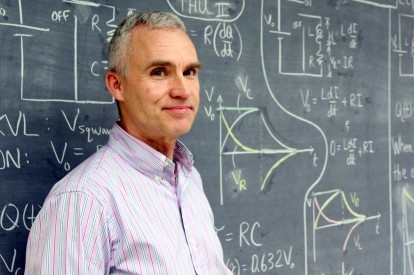A refresher in mathematics
Math can be tough, especially if you haven’t studied it in awhile.
By Kris Foster To help students registered in first-year physics classes polish their math skills, two instructors in the Department of Physics and Engineering Physics have been teaching the Physics Math Review Course.
To help students registered in first-year physics classes polish their math skills, two instructors in the Department of Physics and Engineering Physics have been teaching the Physics Math Review Course.
"We've been doing this for about 20 years now," said Brian Zulkoskey, who, with Stan Shadick, leads the lecture-style course over three evenings at the start of the school year. "We review all of the math that will be needed in first-year physics."
It is a popular course too, Zulkoskey explained, because Physics 115 is a prerequisite for a number of health science fields like medicine, dentistry and veterinary medicine.
"We typically get about 60 students each year. It's stable attendance year to year. A lot of the students need first-year physics to get into professional colleges and have left this class until fourth year, meaning they haven't taken math in four or five years—they don't remember it from Grade 11 or 12. In the past five years or so, we have also seen that the math taught in high school has changed … students haven't seen as much of the material as in the past."
The instructors in first-year physics, he continued, "recognized that better math skills were needed (for success). It's not that the students aren't bright; they have different (academic) backgrounds, such as biology or anatomy, and they need a bit of math help, often just a refresher."
So Shadick and Zulkoskey cover basic algebra, basic trigonometry and vectors during the three two-hour night sessions. "We use a typical lecture format in which we cover a topic and then give the students plenty of time to solve an example problem," said Zulkoskey.
Problem solving is one of the main reasons physics is a required class for so many fields of study.
"What I always stress about physics, and most sciences, is that it teaches you to solve problems. Standard problem- solving methods used in physics can be applied to many problems and help organize your thoughts logically."
Zulkoskey uses an example from medicine. "When doctors see patients, they need to assess symptoms (collect data), make a diagnosis (analyze the data) and prescribe treatment (determine a solution). The standard problem solving method we teach can help."
And the feedback, from instructors and students alike, has been very positive. "We don't track the success of students after they take the course, but we always receive positive feedback from them after they finish."

